Outrun – Homebrew better than Official Releases
I’ll preface this article by just saying I am not an Outrun expert in gameplay, nor its development history – but I am indeed a big fan of the game.
Game Developer and Producer Yu Suzuki joined Sega in 1983. He went on to create one of my all-time favorite games – Outrun. I have read that Suzuki was inspired to develop Outrun because he was a big fan of the 80s movie The Cannonball Run. That movie is about an illegal across America car race with entrants who will do anything to win, including playing dirty tricks on competitors. Even with that inspiration, stages do not take influence from actual American roadways. Instead, all roads represent European highways found in France, Germany, Switzerland, and Italy.

Released in 1986, Outrun was a colossal arcade success. The first driving game that I can recall offering a ‘force-feedback’ self-centering style steering wheel. There was also ‘deluxe’ sit-in cabinet with hydraulics to play. The only other hydraulic cabinet game at the time was Space Harrier — a sci-fi rails shooter that Suzuki was involved with as well — also released by Sega. The deluxe cabinet was in my area quite common. I enjoyed that it moved in your steering direction and tilted up or down depending upon how the road flowed. Outrun had two other arcade cabinet variations: an upright cabinet and a ‘standard’ cabinet with no hydraulics.
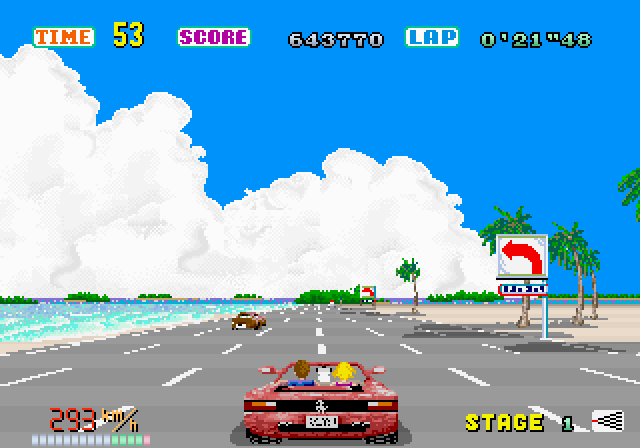
The car driven is a beautiful red convertible Ferrari Testarossa, capable of a top speed of just under 295km/h. Your male driver character is seated beside a blonde-haired woman. Your goal is to drive well enough through the traffic while staying on the road. You have 75 seconds to reach the checkpoint at the end of the stage. Upon reaching the checkpoint, your timer extends, allowing continued play into the next stage. Via the DIP switches, it is possible to adjust the initial timer to 80 seconds to make it easier to complete the first stage.
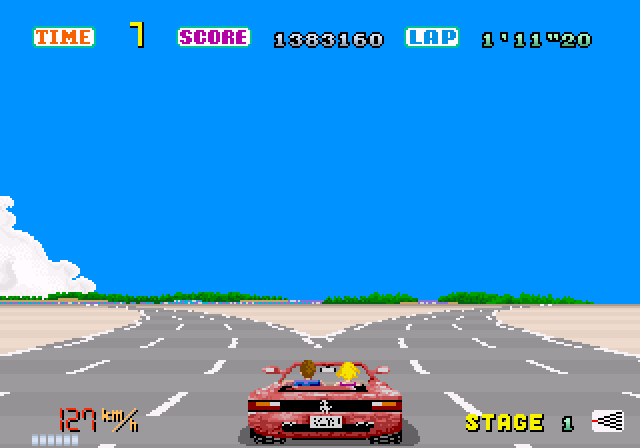
Just before the checkpoint at the end of the stage, you will reach a fork in the road. By choosing the left route, you will drive a slightly easier stage. By choosing the right route, it will be a marginally quicker but more challenging stage. It is game over when you either run out of time or if you complete all five stages. Each time you hit a car or a piece of scenery, you will lose time. Any collisions at high speed will cause your vehicle to flip, which wastes a decent amount of your timer.
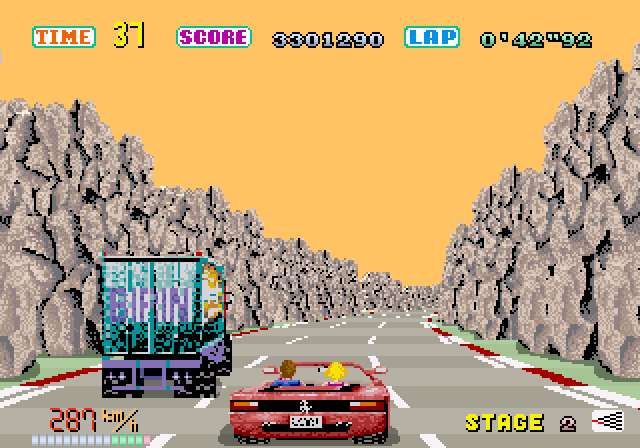
My preferred route to travel is to take the right fork into Devil’s Canyon. Next, take the left fork into Snowy Alps. After this, choose the right route into the Wheat Field. Finally, the right turn into the Autobahn. Taking this route is quite challenging, and you will finish at Goal D.
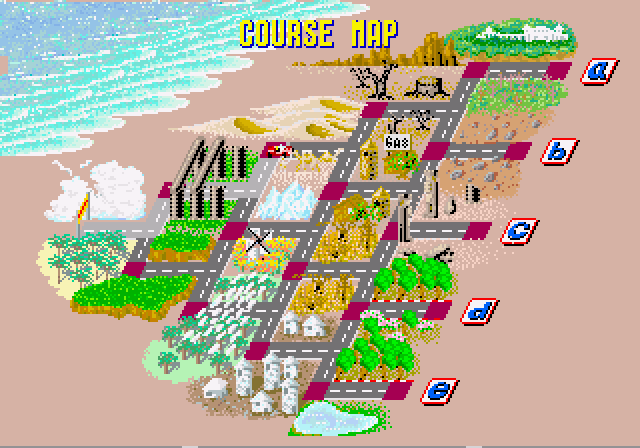
Six of the Best Things About Outrun:
- The deluxe hydraulic cabinet and the usage of a ‘force-feedback’ self-centering style steering wheel felt quite responsive and realistic.
- The game’s usage of gradients in the sky shows different times of day — and how smoothly the sky and scenery transform when you enter each new stage.
- The game view is different from many arcade racing games at the time. It’s almost like the ‘chase mode’ view you see in another Sega game Afterburner where the camera’s perspective is behind the rear of the vehicle. Due to this camera view, you cannot reverse or turn around the car.
- It was the first game where you could select your choice of background music via a simulated radio. My favorite ‘station’ is called Magical Sound Shower. You could select Passing Breeze or Splash Wave if you prefer.
- It was the first non-linear time-limited driving game ever to hit the arcades — giving you various routes to reach one of the five goals.
- Yu Suzuki was also involved with these great games from Sega: Space Harrier, Hang-On, Virtua Fighter, and Ferrari F355 Challenge.
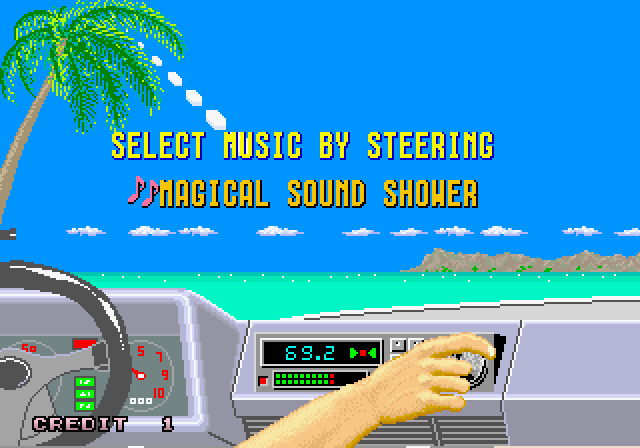
8-bit Computer and Console Conversions
With the arcade version a major success, Sega quickly (in a year) ported Outrun to the Sega Master System. Considering this port is running on an 8-bit console with significant hardware differences, this port was great – but it’s more a solid driving game using the Outrun theme than an Outrun port. Controversially I place this above the MegaDrive version. The speed of this game makes it fun to play — such a fluid game with responsive controls.
Except for the NEC PC Engine version, all other 8-bit ports had major portions of the game removed or modified. Here are a few examples:
- The ZX Spectrum port has no in-game music and featured a companion music cassette with the Outrun arcade game tunes. It’s quite a valiant attempt for the machine the programmers were making this on – but it still falls flat.
- The Commodore 64 version has no fork in the road and most of the scenery removed. This sacrifice did allow for a faster and more playable game. The C64 disk version gives you five different game versions to load — one for each possible goal — but wow, the tire noises are ear-splitting.
- The CPC Amstrad version struggled to provide smooth driving. Sadly it was quite unplayable due to the slow, stuttering framerate.
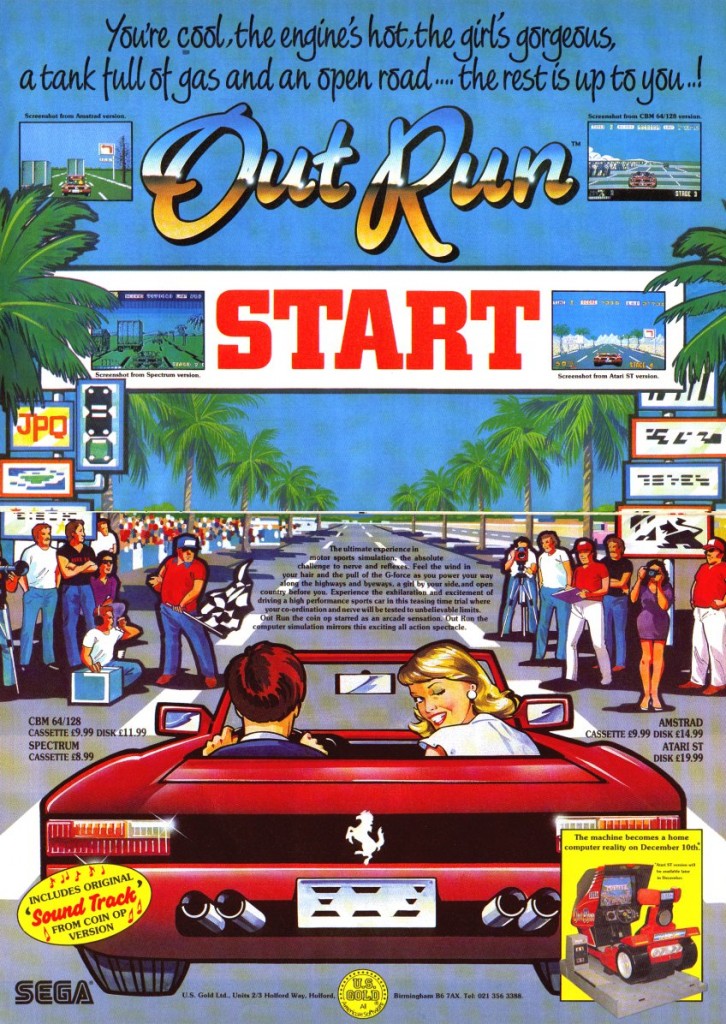
16-bit and 32-bit Computer and Console Conversions
You might wonder why there was no Sharp x68000 port of Outrun — especially knowing how fantastic the Space Harrier and Hang-On ports are. It was under development, but due to issues was canceled. In my mind, it would have been the best port.
The Sega Mega Drive (Genesis) version is possibly the best-known port, and most played 16-bit version. While the Mega Drive port does feel quite complete, I am not a fan. I think the road feels relatively narrow, and with more traffic on the roads, it makes it hard to maneuver without crashing and, therefore, less enjoyable. The sounds are nice, but the music was poor for 16-bits. It is still a favorite for many people, mainly because they have never played the PC Engine version.
Many other 16-bit ports are inferior to the 8-bit ports. Here are a few more examples:
- The Atari ST version looks like it is a port of a port — the ZX Spectrum version, to be precise. While the graphics are updated, I found this version a MAJOR disappointment. The speed of the game was slow and stuttered. In-Game music sounds like it has gone through a phaser guitar pedal.
- The Commodore Amiga version feels like a port of the Atari ST port. The intro is genuinely bizarre — Out Ra Un Un Un. AVOID this version.
- The PC DOS version is playable, but the car is very low to the ground, making it not feel like Outrun.
- The Sega Saturn conversion of Outrun is an accurate port – however, the Saturn controllers personally made this game not enjoyable.
NEC PC-Engine (Turbo Grafx 16) (1990)
My favorite conversion of Outrun
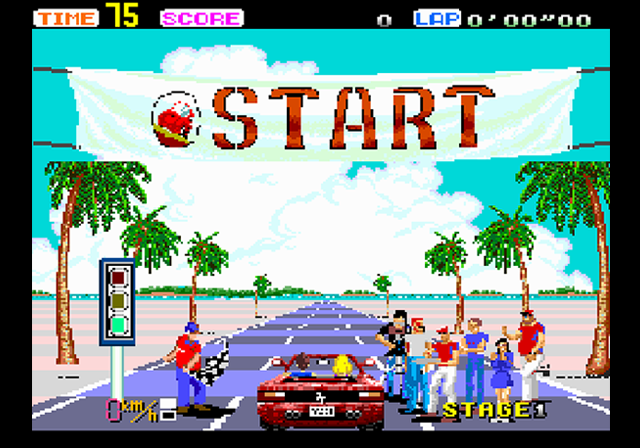
Easily the best home console version of Outrun. It is a very faithful conversion, with great graphics, music, and sound. Most importantly, it keeps the feel and speed of the arcade version. A few missing scenery items in Stage 1, and a couple of other graphical compensations with textures, but the faster game speed and playability are more critical. It controls well, and I think anyone who plays this version will enjoy it.
What could be better than Outrun?
Outrun 2, of course! Outrun 2 improves upon the original Outrun formula by offering 15 revised stages. You also have more cars to choose from — 8 cars on the arcade version and 12 cars on the console version. The game includes more background songs to choose from, including the original tracks remade and four new ones. The game adds a drift feature to slide the car unrealistically sideways around the corners while maintaining your speed.

Outrun 2 added two new game modes: Time Attack mode, which is a race against the clock on a pre-defined course, and Heart Attack mode where your girlfriend requests you to perform tasks to impress her and increase your score — such as knocking over as many of the cones on the road as you can without crashing.
Outrun 2006 — Coast to Coast (known as Outrun 2 SP in the arcades) is an ‘upgraded’ version of Outrun 2 and was released together with Outrun 2 on the same 2006 PlayStation 2, PlayStation Portable, and Xbox release.
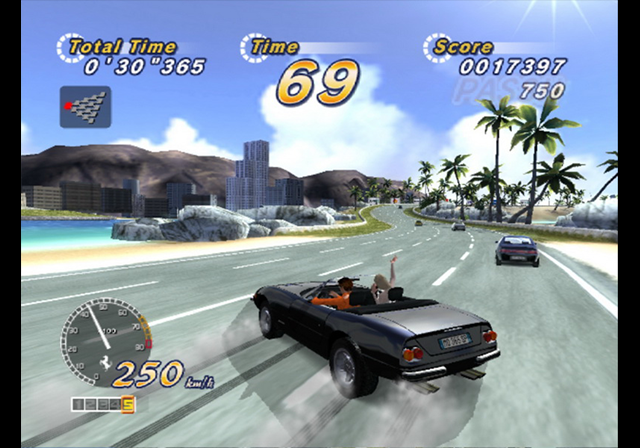
It is, I feel, the ultimate Outrun compilation. Improvements over Outrun 2 include a new slipstream feature to use the traffic to your advantage, driving faster with less resistance. 15 new additional stages, and improving the graphics up to HD resolution, and you are one happy Outrunner.
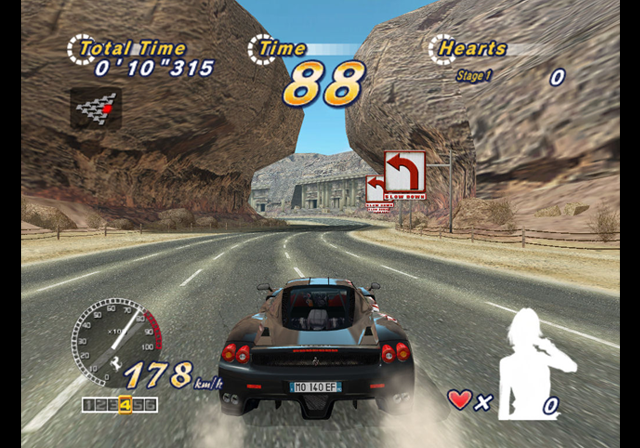
CannonBall – The Enhanced Outrun Engine – Ported to the Amiga
As I eluded to in the title, and knowing that the Amiga port of Outrun was abysmal – this was very welcomed, but looks sadly to not be progressing much further. Thanks to YouTuber “ModernVintageGamer,” in 2017, he ported the CannonBall engine (https://github.com/djyt/cannonball) to the Amiga. Unfortunately, it still has a few caveats. Not even the most powerful stock Amiga will be able to run this.
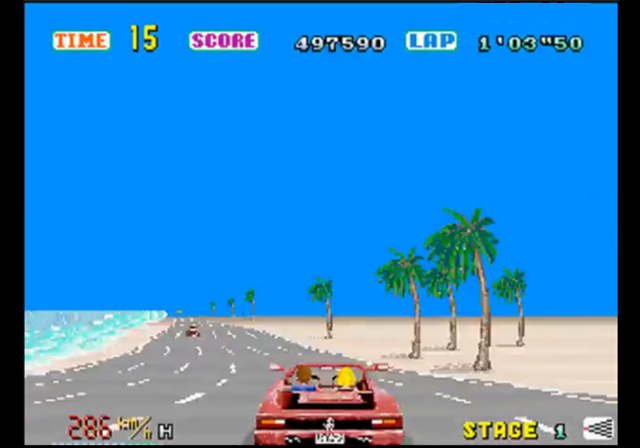
The minimum spec to run this is a Vampire 2 board with Gold 2 core or better – with the Revision B version of the Outrun Amiga ROMs. As with many other Outrun ports, this port has backgrounds and shadows disabled for better framerates – along with the music routines replaced with native MOD files.
Not having this kind of hardware setup myself, I have not been able to test this version of the game. If you are interested in it, the game is available on AmiNet: http://aminet.net/search?query=cannonball
I still think the Amiga, especially the A1200, is a very capable machine and something could have been made that was closer to the PC Engine version. Perhaps this is a project that someone might want to take on again one day. We can only hope.
Thanks for taking a look at my thoughts on one of my favorite arcade games of all time. I have also published about Rygar, another arcade game I love.

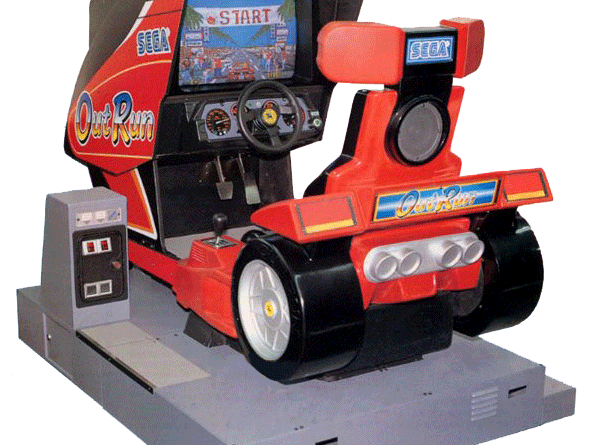
The PC Engine and its 8bit CPU continue to impress. If the rest of the USA was like my hometown, they sold few- if any, because the retailers didn’t plug it in and have it out for demonstration like they did the NES. It was just a cardboard box on a shelf and it was hard to know how awesome some of the games were unless you knew somebody who had one… and nobody was willing to be the first guy to take the chance on buying an unknown system. The good news in modern times is it’s a great system to explore. Pick up a flashcart and go wild! AliExpress has one $30 shipped with microSD packed full of games. “TURBO 500 IN 1”
Nice article Sir Graham, thanks.
I agree with you regarding the MegaDrive version, it was not particularly good looking moreover its frame rate is actually pretty low, barely above 15 FPS which for the console is quite abysmal. It’s quite weird given that SEGA did the conversion themselves so it’s a bit weird that they did not put more effort into it. This said, their conversion of Super Hang On on the machine is equally lackluster so maybe it was the same team who ported both games.
Regarding the Amiga, I am fairly certain the A500 was perfectly capable of hosting a competent OutRun port which would have needed only a minimal amount of compromises. Eventually we’ll get such one port. 😉